The word “metamorphosis” comes from the Greek which means to transform. Metamorphosis is the process of transformation of an immature larval individual into sexually mature reproducing adult. The transformed adult is completely different from larvae in form, structure and habit. It is the way insects grow and mature. Their lives are divided into separate stages for resting, growing and reproducing.
Humans grow gradually. You began life as a baby and grow a little at a time until you’re an adult. While you’re growing, the basic plan of your body doesn’t change. You have the same body your whole life. Insects grow in stages and the cycle of stages is metamorphosis. For many insects, the stages are so different from one another that you might not recognize them as the same animal.
There are four types of metamorphosis in insects namely,
Most insects begin life as an egg and hatch within a few days of being laid. But there are some insects that will live through an entire season as an egg before hatching. The insects that stay in the egg longer need more time to grow and become strong enough to live outside of the egg. When the temperature becomes warm and comfortable these tiny insects will break out of their eggs and, depending on the species, will go through any of the above said types of metamorphosis.
The following is the description of types of metamorphosis,
This type of metamorphosis is also known as ametabolous development. In this type, the newly hatched creature looks like an adult except in size and differences in armature of spines and setae.
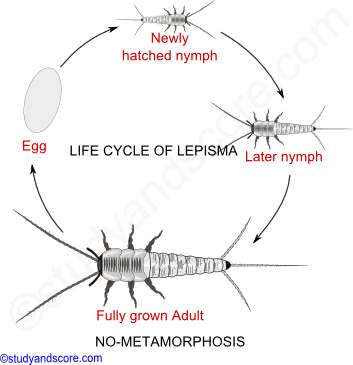
| Examples | Orders |
|---|---|
| Silverfish | Collembola |
| Springtail | Collembola |
| Chewing lice | Mallophaga |
| Sucking lice | Anoplura |
This type of metamorphosis is also known as hemimetabolous development. In this type, the immature stages are called as nymphs or naiads. These immature stages are aquatic and they respire with the help of tracheal gills. On the other hand the adults are terrestrial and respire with the help of tracheae.
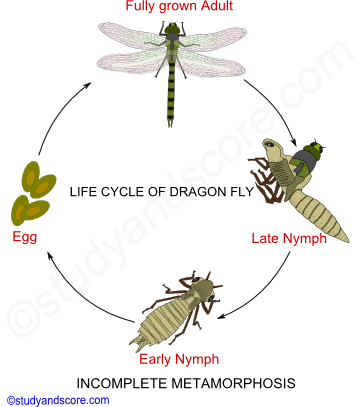
| Examples | Orders |
|---|---|
| Grasshoppers | Orthoptera |
| Termites | Isoptera |
| Booklice | Corrodentia |
| Thrips | Thysanoptera |
| Truebugs | Hemiptera |
| Aphids | Homoptera |
| Earwigs | Darmaptera |
This type of metamorphosis is also known as paurometabolous development. In this type, the newly hatched young ones resemble the adult in general body form but lacks wings and external genital appendages. The young nymphs undergo several nymphal stages through successive moulting to transform into adult.
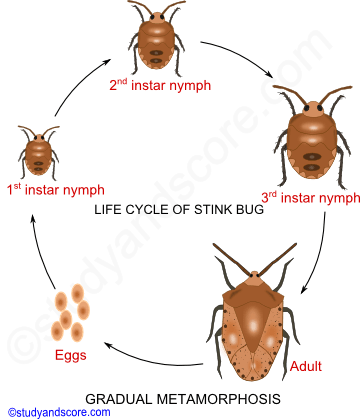
| Examples | Orders |
|---|---|
| Mayflies | Ephemeroptera |
| Dragonflies | Odonata |
| Stone-flies | Plecoptera |
This type of metamorphosis is also known as holometabolous development. In this type, four metamorphic stages are included namely egg, larva, pupa and adult. After hatching larva moults several times to become fully grown one. It later becomes a pupa within a secreted case called as puparium. Inside the puparium, the pupa differentiates into adult and then breaks open the case to emerge out.
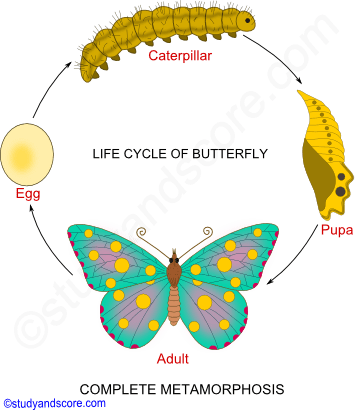
| Examples | Orders |
|---|---|
| Lacewings | Neuroptera |
| Beetles | Coleoptera |
| Scorpion-flies | Mecoptera |
| Coddid-flies | Trichoptera |
| Moths, Butterflies | Lepidoptera |
| Flies | Diptera |
| Fleas | Siphonoptera |
| Wasps, bees | Hymenoptera |
The role of hormones in the physiology of molting was first described by V. B. Wigglesworth in the 1930's. When an immature insect has grown sufficiently, it requires a larger exoskeleton then the sensory input from the body activates certain neurosecretory cells in the brain. These neurons respond by secreting brain hormone (BH) which triggers the corpora cardiaca to release prothoracicotropic hormone (PTTH) into the circulatory system. This sudden release of PTTH stimulates the prothoracic glands to secrete molting hormone/Prothoracic gland hormone (PGH). These PGHs are ecdysteroids which trigger moulting process.
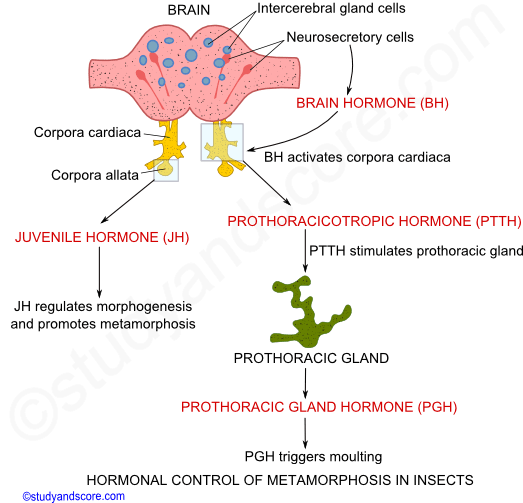
PGH affects many cells throughout the body, but its principle function is to stimulate a series of physiological events also known as apolysis. Apolysis leads to synthesis of a new exoskeleton. During this process, the new exoskeleton forms as a soft, wrinkled layer underneath the hard parts of the old exoskeleton. The duration of apolysis ranges from days to weeks, depending on the species and its characteristic growth rate. Once new exoskeleton has formed, the insect is ready to shed off its old exoskeleton. At this stage, the insect body is covered by two layers of exoskeleton and it is called as pharate.
Toward the end of apolysis, ecdysteroid concentration falls, and neurosecretory cells in the ventral ganglia begin secreting eclosion hormone. This hormone triggers ecdysis, the physical process of shedding the old exoskeleton. In addition, a rising concentration of eclosion hormone stimulates other neurosecretory cells in the ventral ganglia to secrete bursicon, a hormone that causes hardening and darkening of the integument due to the formation of quinone cross-linkages in the exocuticle (sclerotization).
In immature insects, juvenile hormone (JH) is secreted by the corpora allata prior to each molt. This hormone inhibits the genes that promote development of adult characteristics causing the insect to remain in immature state. Corpora allata becomes atrophied during the last larval stage and stops producing juvenile hormone. This releases inhibition on development of adult structures and causes the insect to molt into an adult
At the approach of sexual maturity in the adult stage, brain neurosecretory cells release a brain hormone that "reactivates" the corpora allata, stimulating renewed production of juvenile hormone. In adult females, juvenile hormone stimulates production of yolk for the eggs. In adult males, it stimulates the accessory glands to produce proteins needed for seminal fluid and the case of the spermatophore. In the absence of normal juvenile hormone production, the adults remain sexually sterile.
The following table contains the details of the hormones involved in the process of metamorphosis,
| Hormone | Secreted by | Chemical nature | Function |
|---|---|---|---|
| Brain Hormone (BH) | Neurosensory cells | Lipids | Activates corpora cardiaca |
| Prothoracicotrophic hormone (PTTH) | Corpora cardiaca | Ecdysteroids | Stimulates prothoracic glands |
| Prothoracic gland hormone (PGH) | Prothoraacic glancs | Ecysone | triggers moulting |
| Juvenile hormone (JH) | Corpora allata | Lipids | Regulates morphogenesis and promotes metamorphosis |

- Share with your friends! -

Arti Rajpoot on Jan 09, 2019 at 12:07 pm
Sir your material is extremely good and to the point. But when will you upload next phyla and other materials
Login to post your comment here...
- or with social Account -